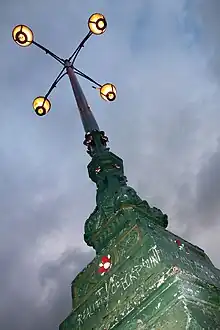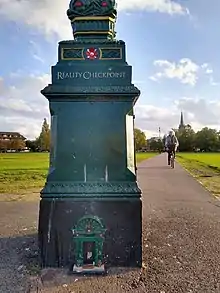


Reality Checkpoint is a large cast-iron lamppost in the middle of Parker's Piece, Cambridge, England,[1] at the intersection of the park's diagonal paths.[2][3]
Origin of the name
There are three main theories as to the meaning of the name.
- It may mark the boundary between the central university area of Cambridge (referred to as the "reality bubble") and the "real world" of townspeople living beyond. One is warned to check one's notions of reality before passing.[4]
- The name arose because the lamppost forms a useful landmark for people crossing the park at night – perhaps intoxicated or in the fog – since it is the only light for over a hundred metres.[5]
- When drunk, students and the general public are reminded to check they are able to walk like a sober person before passing the police station at the edge of Parker's Piece, hence a "reality check".[6][7][5]
History
A lamp at the centre of Parker's Piece was first proposed in 1890[8] and work commenced in January 1894 when a pipe was laid from Parkside, running parallel with the path opposite Melbourne Place. Once the connections were completed, the pillar was erected. This attracted a great deal of interest and was described as a "very handsome ornament to the Piece".[9] It is made of cast iron by the Sun Foundry of George Smith and Company in Glasgow. It stands on a square-section plinth with waterleaf decoration on the top edges. The base of the shaft of circular section is encircled with four intertwined heraldic dolphins. The shaft carries four lamp holders by means of scrolled wrought iron stays. It is said to be the oldest electrical lamppost in Cambridge.[10]
A photograph from around 1903 shows the lamppost with a single lamp.[11][12]
The post above the dolphins was torn down by American soldiers celebrating Victory over Japan Day, the end of the war with Japan. In September 1946 the lamppost was repaired by a local metalworks firm, George Lister & Sons, Cambridge. The work was done by foreman Sam Mason, assisted by a young apprentice, Tony Challis, who did the scrollwork at the top of the lamppost.[5][13] Challis still lives in Cambridgeshire and is also responsible for the ornate railings found at Grantchester Meadows. The current design with four pendant lamps dates from the 1946 repair.
In 1996 the lamppost was designated as a Grade II listed building.[14]
In 2016–17 Cambridge City Council restored the lamppost, reinstating its earlier colours of moss green, red, white and gold, and casting any new parts as required.[5][15][16]
In 2018, anonymous local art installers, Dinky Doors, installed a reality checker "door" on the checkpoint, which was refurbished in 2019.[17][18]
Inscription
One report claims that the name was first painted on the lamppost in the early 1970s by students from Cambridgeshire College of Arts and Technology (now Anglia Ruskin University) under the guidance of one of their teachers.[10] Another claims that it was originated in 1970 by the Emmanuel Liberation Front (ELF), one of whose members first scratched the name onto the lamppost. The ELF was a group of radical students at Emmanuel College between 1969 and 1971 influenced by the Situationists with their slogan "Do not adjust your mind. There is a fault in reality." Emmanuel adjoins the northwest side of Parker's Piece.
Until the early 1970s, the lamppost was painted a dishwater grey or discoloured cream.[5] In 2017 two brothers, David and Sandy Cairncross, revealed that they had been responsible for repainting it in bright colours in October 1973, a task undertaken with the written permission of Geoffrey Cresswell, the Cambridge City Engineer.[5] At the time, David was a student at King's College, Cambridge and Sandy, a postgraduate research student (now a distinguished epidemiologist). The repainting did not involve anyone from Cambridgeshire College of Arts and Technology.
The Cairncrosses confirmed that the name "Reality Checkpoint" had previously been inscribed in marker pen on the pillar "a year or two earlier" and that their painting of the name was initially a placeholder for more sophisticated lettering.[5] On how the lamppost got its name, David acknowledged the influence of Checkpoint Charlie during the Cold War, and the popularity of Carlos Castaneda’s 1971 memoir A Separate Reality.[5]
The Cairncrosses' repainting remained throughout the 1970s and into the 1980s. By 1980 however, the lamppost was looking shabby, as was clear in a photograph of the poet Tom Raworth taken next to it in 1980.[5] Eventually Cambridge City Council painted over the decoration with a dull faux verdigris.
Since then, the name has been informally inscribed or scratched into the paintwork many times, despite its repeated removal by Cambridge City Council or obliteration by graffiti. At one point in the mid-1990s, according to Graham Chainey writing in The London Magazine,[19] "Reality Checkpoint" was scratched on one side of the plinth, while on the opposite side was scrawled "The Comfortably Numb" - a reference to a song on the album The Wall by the Cambridge band Pink Floyd.
For the first half of 1998 the lamppost carried an unofficial plaque bearing its name, until removed by the council.[2]
Comedian Ben Miller featured the lamppost in his BBC Two physics documentary "What Is One Degree?" for the science series Horizon.[20] At that time, the lamppost had the words "Reality Checkpoint" scratched into its paintwork in at least two places.
The inscription was restored in June 2017 by artist Emma Smith, with the approval of the Cambridge City Council, as part of the art project 'Hunch' commissioned by the University Arms Hotel.[21][22]
References
- ↑ Baker, Mike (2001). "Not in front of the parents: How 'education speak' prevents teachers from being heard". Critical Quarterly. 43 (1): 19–24. doi:10.1111/1467-8705.00333.
- 1 2 Hollis, Edward (2009). "Reality Checkpoint" (PDF). CAM (Cambridge Alumni Magazine) (57 (Easter 2009)): 22–27. Archived from the original (PDF) on 16 July 2011. Retrieved 16 August 2009.
- ↑ Cambridge News - Lighting trialled on Parker's Piece amid safety fears Archived 30 January 2013 at the Wayback Machine "...the central column known as Reality Checkpoint..."
- ↑ "Real World". The Jargon File. Eric S. Raymond. 29 October 2003. Retrieved 11 February 2008.
- 1 2 3 4 5 6 7 8 9 Webb, Robert (2018). "Reality Checkpoint". Retrieved 17 May 2018.
- ↑ "Restoration calls for 'Reality Checkpoint' on Parker's Piece as pictures show its decline". Retrieved 4 May 2016.
- ↑ "Cambridge Parkside Police Station". Google place page. Google Maps. Retrieved 27 April 2014.
- ↑ Cambridge Independent Press, 18 January 1890.
- ↑ Cambridge Independent Press, 2 February 1894.
- 1 2 "Parker's Piece, Cambridge". Archived from the original on 4 August 2017. Retrieved 26 September 2008.
- ↑ "Parker's Piece, Cambridge. c. 1903". Retrieved 27 April 2014.
- ↑ "Parker's Pieces". 28 January 2012. Retrieved 27 April 2014.
- ↑ Cambridge Daily News, 5 September 1946
- ↑ "Lamp Standard, Cambridge – 1268376 | Historic England".
- ↑ "'Reality Checkpoint' to be restored to former glory | Cambridge City Council". www.cambridge.gov.uk. Archived from the original on 28 August 2016. Retrieved 7 July 2016.
- ↑ Leng, Freya (2 August 2016). "Cambridge's most famous street lamp just weeks away from being restored to former glory". Cambridge News. Retrieved 2 August 2016.
- ↑ "Art Installation …. Dinky Doors … arrives in the city. Can you find them? April 2019 : Cambridge Tourist Information". www.cambridgetouristinformation.co.uk. 1 April 2019. Archived from the original on 3 August 2019. Retrieved 1 July 2019.
- ↑ "Dinky Doors". Dinky Doors. Retrieved 1 July 2019.
- ↑ "The Other Cambridge", 1995
- ↑ "What Is One Degree?". Horizon. 10 January 2010. Retrieved 10 January 2010.
- ↑ Elliott, Chris (3 June 2017). "Getting to the bottom of the legend of Reality Checkpoint in Cambridge". cambridgenews. Retrieved 3 June 2018.
- ↑ Cox, Tara (7 June 2017). "Reality Checkpoint given a makeover as name officially painted on listed monument". cambridgenews. Retrieved 3 June 2018.